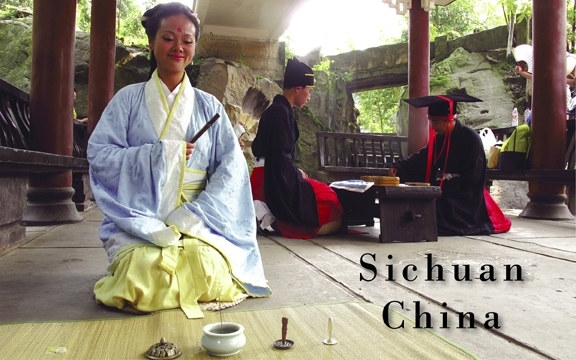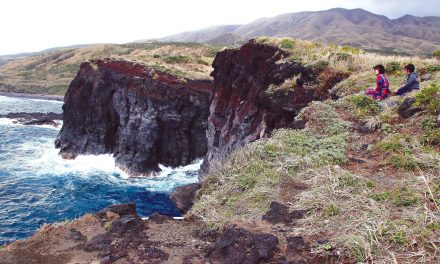Sichuan, China
Cuisine, History, Culture…and Pandas too!
Article & Photography by Michael Morcos

Sichuan Province is one of the largest provinces in China, with a generous mix of plains, hills, mountains and plateaus that offer landscapes any artist would love. Located in southwest part of the country, it is a gateway to Tibet, and its capital city, Chengdu, is a cultural and industrial center famous for its luxurious satins, brocades, and lacquer products since the 13th century.
Abundant natural beauty can be found within the stunning landscapes that include ravines, rivers, hot springs, waterfalls and limestone caves. Some local areas have been developed into scenic sites for tourism, including the Lizhuang ancient city, Xingwen Stone Sea and Tianquan Cave, and the mountains host more than 50 kinds of rare animals, including giant pandas that visitors can see at the Chengdu Panda Breeding and Research Center (one of the most important research centers in the world for the conservation of giant pandas).
There is a rich, textured history and culture that can be found here, as Sichuan is one of the birthplaces of the Chinese nation and plays an important role in China’s history. As early as 25,000 years ago, civilization appeared here and has left this area abundant in historical heritage.
The City of Yibin is a fine example of this historical significance. Among many attractions there lies ancient buildings and structures that date back through the ages.
Natural wonders abound with several hot springs near Yibin, including the Bamboo Sea (acres and acres of Bamboo plants) and the Xingwen Stone Forest.
The Cuiping Mountain in the centre of the city provides wonderful views of Yibin from all angles. Liubei Pond Park is Sichuan Province’s most famous scenic spots and is famous for inspiring the great calligrapher Huang Tingjian. This tranquil park also has live actors who dress in ancient clothing and go about life as if we were in old China. An amazing glimpse into the past of this ancient culture!
Yibin is also home to the Wuliangye Group who produce a very popular national alcoholic drink. Their headquarters is so large, it is like a city within a city! The company is important to the area as they are the biggest employer in town, and the locals are proud of the connection.
The profound cultural heritage of the city makes it one of the most famous historical and cultural cities in China. Bamboo craftwork and bamboo related foods are popular, and offer tourists a sample of the local cuisine and an opportunity to purchase unique gifts.
Lizhuang is another ancient city by the Yangtze River, where visitors are treated to a trip back through time juxtaposed with luxurious buildings in the old street of Lizhuang Town. For visitors, there is the Xuanluo Hall (Hall of Spiral), where a palace named Wenchang Hall lies waiting to be explored. The main hall of this palace is a wooden pavilion where the architect made full use of the principle of mechanics, creating a magical spiral-shaped hall. Incredible feat of engineering.
Life moves very slowly here, but there are a great number of markets where the Sichuan local cuisine, known worldwide, is available, inexpensive and delicious.
As in most of China, we were treated to colourful shows, costumes, music and dance, but the Xingwen Miao Minority Folk Residence is one of the best spots for this. The Miao are one of the biggest minority groups in China and in their new complex they treat visitors to song, dance and art exhibitions. With the intricate moves and fabulous costumes, it is easy to understand how China can produce such amazing shows at events like the Olympics when local shows are this good!
The Xingwen Stone Sea is a world famous scenic spot with amazing features, including the longest natural scenic viewing limestone cave in China called the Tianquan Cave, which holds a record in space and length. With stone flowers, stone bamboo, stone pillars and more, the cave system has features that will please every cave fan, including my favourite, an underground river! The surface stone sea extends 10 kms from east to west, and 4 kms from South to North with wonderful shapes and imposing features. There are stone peaks to the south and a dense stone forest covers the west and north, with the great ‘Peak of Couples’, standing just like a couple with hand in hand.
Another interesting feature of the park is a gigantic sinkhole, the largest in the world! The sinkhole is about 650m long and 208m deep!
These caves are among the best I have ever visited, at times imposing, and other times awe-inspiring. The park has made it easy to walk around as everything is well lit and the paths are easy to walk.
The Bamboo Sea of Southern Sichuan is one of the largest bamboo forests in China and has been among the most well-known tourist destinations for visitors. It is a natural wonderland created and, a place that is far more mysterious than the mundane world of everyday tourism. The core area holds over 5000 hectares of huge and upright bamboo shelters ridges, peaks and hills stretching all around the area. It looks like a vast green sea with a bamboo forest containing further treasures, including the Rainbow Waterfall and the Fairy Lake among others. The Waterfall is a towering 200 meters high and as the sun shines on the waterfall, rainbows are often seen. The Fairy Lake is the ideal location for tourists to enjoy bamboo rafting.
A final spot on this journey through Sichuan Province was a once in a lifetime trip to the Chengdu Panda Bear Research Center and it is the world’s only place that focuses entirely on the critically endangered giant Panda. This is one of the highlights in the city of Chengdu, Sichuan, as well as in China, and was a true highlight of the trip. The place is enormous and there is ample space for the animals – a rarity in the zoo world. The animals were very active while we were there, and the Panda cubs were absolutely adorable. We were very lucky, as the Panda handlers had brought the young cubs out for us. Though we were not allowed to touch them, we were allowed to take photos and videos of them.
They also have a cinema showing documentaries of pandas, offering a deeper understanding of these interesting creatures.
www.tourismchina.org

















